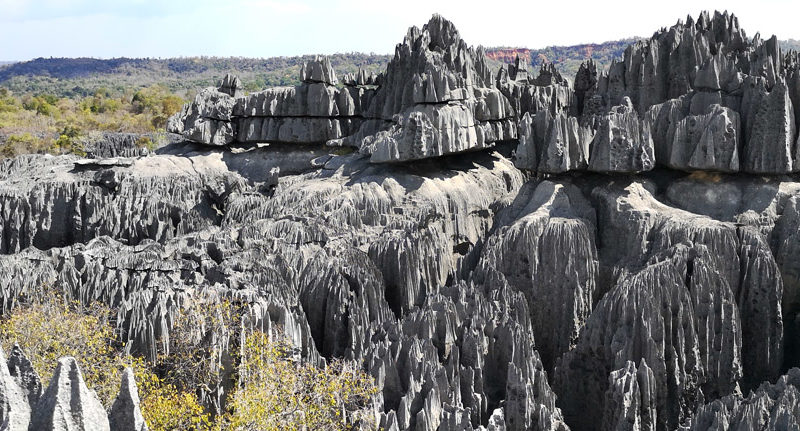Discover the Wonders of Tsingy de Bemaraha: Madagascar’s Unique Geological Marvel
Madagascar is a land of breathtaking landscapes, unique wildlife, and rich biodiversity. Among its most remarkable natural wonders is Tsingy de Bemaraha, a UNESCO World Heritage Site that captivates every visitor. With jagged limestone formations, deep canyons, and rare wildlife, it is unlike anywhere else on Earth. This guide will take you through everything you need to know about Tsingy de Bemaraha, from its geology and wildlife to travel tips and adventure activities.
What is Tsingy de Bemaraha?
Tsingy de Bemaraha is a vast limestone karst landscape in western Madagascar, covering about 152,000 hectares. The word “Tsingy” means “where one cannot walk barefoot,” which describes the sharp, needle-like limestone formations. These structures have been shaped by erosion over millions of years, creating a dramatic and otherworldly landscape of pinnacles, cliffs, caves, and canyons.
The park is divided into two main areas:
-
Petit Tsingy (Small Tsingy): Easier trails for families and casual hikers.
-
Grand Tsingy (Big Tsingy): Challenging routes with rope bridges and ladders for experienced adventurers.
Both areas showcase Madagascar’s natural beauty and unique ecosystems, making Tsingy de Bemaraha a must-visit destination.
History and UNESCO Recognition
Tsingy de Bemaraha became a UNESCO World Heritage Site in 1990 because of its unique geology and rich biodiversity. Local Malagasy communities have lived near Tsingy for centuries, respecting its sacred areas and relying on the forest for traditional medicine and resources.
Today, the park is protected to preserve its fragile ecosystems and to promote sustainable tourism. Visiting Tsingy de Bemaraha helps support conservation efforts while offering a memorable adventure.
The Unique Geology of Tsingy de Bemaraha
The sharp limestone pinnacles of Tsingy de Bemaraha were formed by karst processes, where acidic rain slowly dissolves rock, creating deep fissures and towering needles. Some pinnacles rise up to 100 meters, forming a maze of narrow pathways and cliffs.
-
Grand Tsingy: Vertical and extreme, perfect for experienced climbers and hikers.
-
Petit Tsingy: More accessible, with gentle trails and panoramic viewpoints.
The dramatic formations are both beautiful and functional, creating microhabitats for many unique species.
Wildlife in Tsingy de Bemaraha
Tsingy is home to Madagascar’s unique wildlife, much of which is found nowhere else in the world.
Lemurs
Look out for species such as:
-
Decken’s sifaka – famous for its elegant hopping movement.
-
Red-fronted brown lemur – often spotted in trees near trails.
Birds
Birdwatchers can spot:
-
Madagascar fish eagle
-
Crested drongo
Reptiles and Amphibians
The park shelters:
-
Chameleons
-
Geckos
-
Rare frogs
Insects
Many unique insects, including endemic butterflies and beetles, thrive in Tsingy’s ecosystems.
Plant Life in Tsingy de Bemaraha
Despite the rocky terrain, plants flourish in Tsingy. You’ll see:
-
Dry deciduous forests in valleys
-
Succulents clinging to cliffs
-
Endemic flora like Aloe and Pachypodium species
These plants make the landscape even more striking and support the park’s wildlife.
Adventure Activities in Tsingy de Bemaraha
Exploring Tsingy de Bemaraha is full of adventure. Popular activities include:
Hiking and Trekking
Trails range from easy walks in Petit Tsingy to challenging routes in Grand Tsingy, with ladders, bridges, and caves to explore.
Rock Climbing and Via Ferrata
Grand Tsingy has via ferrata routes with steel ladders and suspension bridges, perfect for thrill-seekers.
Wildlife Watching
Observe lemurs, birds, and reptiles while exploring the trails. The dramatic landscape provides perfect photography opportunities.
Canoeing on the Manambolo River
Combine a river trip with visits to caves and ancient Malagasy tombs along the riverbanks.
Best Time to Visit Tsingy de Bemaraha
The dry season, from April to November, is the best time to visit. Trails are safer, rivers are navigable, and the weather is ideal for outdoor activities. The wet season, December to March, makes some trails slippery and inaccessible.
How to Get to Tsingy de Bemaraha
Traveling to Tsingy requires planning:
-
By Air: Fly to Morondava, then take a 4×4 transfer to the park.
-
By Road: 4×4 vehicles are necessary due to rough roads; travel from Morondava or Antsalova takes 8–12 hours.
-
Guided Tours: Many travelers prefer guided tours with transport, park fees, accommodation, and expert guidance included.
Accommodation Near Tsingy de Bemaraha
Options include:
-
Eco-lodges: Comfortable stays that respect the environment.
-
Guesthouses: Local hospitality and cultural immersion.
-
Camping: Adventure seekers can camp near the park entrance.
Booking ahead is recommended, especially in peak season.
Cultural Significance of Tsingy de Bemaraha
Tsingy de Bemaraha is also a cultural landmark. Local communities maintain traditions, respect sacred sites, and preserve ancient tombs. Visitors can learn about Malagasy culture through guided tours and interactions with villagers, enriching the travel experience.
Tips for Visiting Tsingy de Bemaraha
-
Hire a guide: For safety, navigation, and insights.
-
Wear sturdy shoes: Trails are rocky and sharp.
-
Bring climbing gear: For Grand Tsingy, use helmets, harnesses, and gloves.
-
Pack water and snacks: Trails can be long and physically demanding.
-
Respect the environment: Do not disturb wildlife or remove plants or rocks.
-
Plan your transport: Roads require a 4×4 vehicle.
Sustainable Tourism in Tsingy de Bemaraha
Visitors can help preserve Tsingy by:
-
Choosing eco-friendly accommodations
-
Supporting local communities
-
Following park rules
-
Avoiding plastic and leaving no trace
Responsible tourism ensures this unique landscape remains for future generations.
Frequently Asked Questions About Tsingy de Bemaraha
Q1: Is Tsingy suitable for children?
Petit Tsingy is family-friendly; Grand Tsingy requires experience and climbing skills.
Q2: How long should I spend in Tsingy?
2–3 days is ideal to explore both Petit and Grand Tsingy.
Q3: Can I visit independently?
Yes, but a local guide is recommended for safety and navigation.
Q4: Are there entrance fees?
Yes, fees vary for locals and international visitors. They support conservation and park maintenance.
Q5: What wildlife can I see?
Lemurs, birds, reptiles, and unique insects are common.
Why Tsingy Belongs on Every Bucket List
Tsingy combines adventure, nature, and culture. Its sharp limestone pinnacles, rich biodiversity, and scenic landscapes make it a must-visit for travelers seeking an extraordinary experience. Whether climbing Grand Tsingy, hiking Petit Tsingy, or spotting lemurs, every moment is unforgettable.
Visiting Tsingy is more than a trip; it’s an adventure into one of Madagascar’s most remarkable natural wonders.
Conclusion
A journey to Tsingy is an unforgettable adventure. From dramatic limestone pinnacles to rare wildlife, it offers thrills, natural beauty, and cultural insights. With the right planning and a spirit of exploration, a visit here becomes a lifetime memory.
Madagascar’s Tsingy is not just a destination—it is a masterpiece of nature and a must-see for every traveler.
HT AGENCY TOURS
Luxury Madagascar with the best luxury African safari tours packages. Discover your next perfect destination with HT Agency Tours

